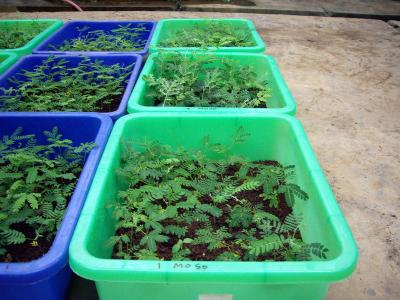Effects of mycorrhizal fungi and biochar 75 Days
Submitted by Tom Miles on Tue, 2008-02-05 05:24.
Effects of mycorrhizal fungi and biochar 75 Days
Robert Flanagan, Hangzhou Sustainable Agricultural Food & Fuel Enterprise Co., Ltd.
(SAFFE), February 5, 2008
I just got to visit my biochar trial at BIOTROP today so I took a few photos to give all you some idea of the profound difference biochar makes to subsoil
 Control
Control
 Rice Husk Charcoal
Rice Husk Charcoal
 Rice Husk Charcoal + VAM
Rice Husk Charcoal + VAM
Video:
YouTube - Effects of mycorrhizal fungi and biochar
What we're seeing is the plants treated with VAM fungi + biochar are a lot darker green and show more plant growth at the 75day mark so I'll push on up to day90 and see what happens.
Robert Flanagan
Chairman & President
Hangzhou Sustainable Agricultural Food & Fuel Enterprise Co., Ltd.
Skype "saffechina"
Tel: 86-571-881-850-67
Cell: 86-130-189-959-57
Robert sent me the link to this article talking about his test of mycorrhizal fungi and biochar on plants:
The above article is here: Terra Preta | Intentional use of charcoal in soil
Submitted by Tom Miles on Tue, 2008-02-05 05:24.
Effects of mycorrhizal fungi and biochar 75 Days
Robert Flanagan, Hangzhou Sustainable Agricultural Food & Fuel Enterprise Co., Ltd.
(SAFFE), February 5, 2008
I just got to visit my biochar trial at BIOTROP today so I took a few photos to give all you some idea of the profound difference biochar makes to subsoil
 Control
Control Rice Husk Charcoal
Rice Husk Charcoal Rice Husk Charcoal + VAM
Rice Husk Charcoal + VAMVideo:
YouTube - Effects of mycorrhizal fungi and biochar
What we're seeing is the plants treated with VAM fungi + biochar are a lot darker green and show more plant growth at the 75day mark so I'll push on up to day90 and see what happens.
Robert Flanagan
Chairman & President
Hangzhou Sustainable Agricultural Food & Fuel Enterprise Co., Ltd.
Skype "saffechina"
Tel: 86-571-881-850-67
Cell: 86-130-189-959-57
Robert sent me the link to this article talking about his test of mycorrhizal fungi and biochar on plants:
The above article is here: Terra Preta | Intentional use of charcoal in soil
 .
.


Comment